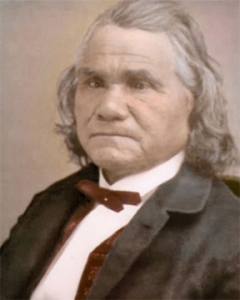
by Daniel Nardini
Born on December 12, 1806, Stand Watie (also known as Standhope Watie) was a Cherokee Native American. He was one of the original signers of the Treaty of New Echota of 1835, the treaty that forced all of the Cherokee to move into the designated Indian territory west of the Mississippi River now known as Oklahoma. Since Watie was a member of the pro-treaty faction of the Cherokee, he was almost killed in an assassination attempt by anti-treaty Cherokee. The majority of the Cherokee did not approve of the treaty, but this did not matter to the U.S. government. All of the Cherokees were forcibly removed to the Indian territory whether they liked it or not. This forcible removal became known as the Trail of Tears because it caused the unnatural deaths of 4,000 Cherokee men, women and children.
This was one of the darkest chapters in American history, and Watie viewed it as a complete betrayal by the United States. When several southern states ceded from the United States, they formed the Confederate States of America. Stand Watie, one of the prominent chiefs among the Cherokee, sided with the newly formed Confederacy. One other Cherokee chief, John Ross, sided with the Union. Like so many other things, the Cherokees were divided between their loyalty to the United States and to the Confederacy. Stand Watie was commissioned as a colonel of a Native American cavalry regiment known as the 1st Cherokee Mounted Rifles. His greatest single achievement of the U.S. Civil War (1861-1865) was the Second Battle of Cabin Creek in which his men captured over $1 million worth of wagons, weapons, mules, commissary supplies, and other badly war material for the Confederacy in 1864. This was not only the greatest but most famous Confederate victory in the Indian territory. For his achievement, he was made a brigader general—the highest position a Native American had attained in the Confederate armed forces.
However, the Confederacy collapsed, and the commander of the Virginia armies, Robert E. Lee, surrendered to U.S. General Ulysses Grant at the Appomattox Courthouse on April 9,1865. Despite all other Confederate forces surrendering to the Union armies, Stand Watie remained an effective fighting force in the Indian territory. His forces tied down significant numbers of Union troops that could have been used to fight against the Confederacy in the east. Nevertheless, Watie knew he could no longer resist the Union forces and so he surrendered on June 23, 1865—the last Confederate general to do so. After the war, Watie tried to lead a part of a delegation to help renegotiate a peace treaty with the U.S. government. The U.S. government did not recognize Watie, but instead negotiated with Cherokee Chief John Ross who had remained loyal to the Union side. Watie retired from politics, and died quietly on September 9, 1871.
As I said before, not just whites but also Afro-Americans, Latinos and Native Americans fought under the Confederate battle flag, and they all had their own reasons why they fought for the Confederacy. It is too simple to say that the first, second and third official national flags of the Confederacy and the Confederate battle flags were nothing more than symbols of hate and slavery. If this were the case, then Stand Watie would not have fought for the Confederacy. The fact is that few Cherokees owned Black slaves, and the Cherokees hoped that by fighting for the Confederacy they would get a better deal than they did from the United States. This information does not fit into the category of the politically correct politicians, nor of those organizations and institutions that would banish, not just publicly but privately, the flags and symbols of the Confederacy. The one thing that is only too clear is that the flags and symbols of the Confederacy are part of our American history, our heritage, and part of our culture. It is true that the first organized Ku Klux Klan did use the Confederate flags and symbols for their racist, repressive terror during the period called the Reconstruction (1866-1871). This came after the Civil War and the flags and symbols that had been created during the Civil War were not seen in the same light then. Trying to banish and sanitize American history will lead to a slippery slope towards censorship and repression.
 Rhapsody Theater Celebrates Cinco de Mayo April 18, 2024
Rhapsody Theater Celebrates Cinco de Mayo April 18, 2024 Earth Day Fun April 18, 2024
Earth Day Fun April 18, 2024 Meeting Challenges Head On April 18, 2024
Meeting Challenges Head On April 18, 2024
 Back of the Yards Holds Vigil Following Tragic Shooting April 18, 2024
Back of the Yards Holds Vigil Following Tragic Shooting April 18, 2024 Auditorium Theatre Announces 2024-25 Season April 18, 2024
Auditorium Theatre Announces 2024-25 Season April 18, 2024






Stand Watie: The Last Confederate General
by Daniel Nardini
Born on December 12, 1806, Stand Watie (also known as Standhope Watie) was a Cherokee Native American. He was one of the original signers of the Treaty of New Echota of 1835, the treaty that forced all of the Cherokee to move into the designated Indian territory west of the Mississippi River now known as Oklahoma. Since Watie was a member of the pro-treaty faction of the Cherokee, he was almost killed in an assassination attempt by anti-treaty Cherokee. The majority of the Cherokee did not approve of the treaty, but this did not matter to the U.S. government. All of the Cherokees were forcibly removed to the Indian territory whether they liked it or not. This forcible removal became known as the Trail of Tears because it caused the unnatural deaths of 4,000 Cherokee men, women and children.
This was one of the darkest chapters in American history, and Watie viewed it as a complete betrayal by the United States. When several southern states ceded from the United States, they formed the Confederate States of America. Stand Watie, one of the prominent chiefs among the Cherokee, sided with the newly formed Confederacy. One other Cherokee chief, John Ross, sided with the Union. Like so many other things, the Cherokees were divided between their loyalty to the United States and to the Confederacy. Stand Watie was commissioned as a colonel of a Native American cavalry regiment known as the 1st Cherokee Mounted Rifles. His greatest single achievement of the U.S. Civil War (1861-1865) was the Second Battle of Cabin Creek in which his men captured over $1 million worth of wagons, weapons, mules, commissary supplies, and other badly war material for the Confederacy in 1864. This was not only the greatest but most famous Confederate victory in the Indian territory. For his achievement, he was made a brigader general—the highest position a Native American had attained in the Confederate armed forces.
However, the Confederacy collapsed, and the commander of the Virginia armies, Robert E. Lee, surrendered to U.S. General Ulysses Grant at the Appomattox Courthouse on April 9,1865. Despite all other Confederate forces surrendering to the Union armies, Stand Watie remained an effective fighting force in the Indian territory. His forces tied down significant numbers of Union troops that could have been used to fight against the Confederacy in the east. Nevertheless, Watie knew he could no longer resist the Union forces and so he surrendered on June 23, 1865—the last Confederate general to do so. After the war, Watie tried to lead a part of a delegation to help renegotiate a peace treaty with the U.S. government. The U.S. government did not recognize Watie, but instead negotiated with Cherokee Chief John Ross who had remained loyal to the Union side. Watie retired from politics, and died quietly on September 9, 1871.
As I said before, not just whites but also Afro-Americans, Latinos and Native Americans fought under the Confederate battle flag, and they all had their own reasons why they fought for the Confederacy. It is too simple to say that the first, second and third official national flags of the Confederacy and the Confederate battle flags were nothing more than symbols of hate and slavery. If this were the case, then Stand Watie would not have fought for the Confederacy. The fact is that few Cherokees owned Black slaves, and the Cherokees hoped that by fighting for the Confederacy they would get a better deal than they did from the United States. This information does not fit into the category of the politically correct politicians, nor of those organizations and institutions that would banish, not just publicly but privately, the flags and symbols of the Confederacy. The one thing that is only too clear is that the flags and symbols of the Confederacy are part of our American history, our heritage, and part of our culture. It is true that the first organized Ku Klux Klan did use the Confederate flags and symbols for their racist, repressive terror during the period called the Reconstruction (1866-1871). This came after the Civil War and the flags and symbols that had been created during the Civil War were not seen in the same light then. Trying to banish and sanitize American history will lead to a slippery slope towards censorship and repression.